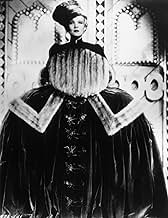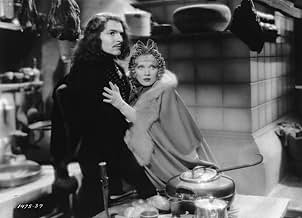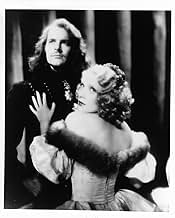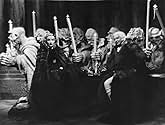A German noblewoman enters into a loveless marriage with the dim-witted, unstable heir to the Russian throne, then plots to oust him from power.A German noblewoman enters into a loveless marriage with the dim-witted, unstable heir to the Russian throne, then plots to oust him from power.A German noblewoman enters into a loveless marriage with the dim-witted, unstable heir to the Russian throne, then plots to oust him from power.
- Director
- Writers
- Stars
- Awards
- 1 win total
- Count Lestoq
- (as Phillip Sleeman)
- Ivan Shuvolov
- (as Hans von Twardowski)
- Sophia as a Child
- (as Maria)
- Lackey #5
- (uncredited)
- Count von Breummer
- (uncredited)
- Sophia's Aunt
- (uncredited)
- Director
- Writers
- All cast & crew
- Production, box office & more at IMDbPro
Featured reviews
In the first half Marlene Dietrich in the title role overplays breathless awe so emphatically that one can only wonder if she was strictly directed to do so; after her sexual awakening after months of resisting the stirring of her passions by a rakish courtier (John Lodge) and crazed with frustration by her unconsummated marriage to the repellent Tsar-to-be Peter (Sam Jaffe), she melts into the arms of a palace guard during a sudden moonlit encounter.
It's hard to believe this film passed the 1934 censors, given its open suggestions of out-of-wedlock sex (and subsequent pregnancy); Dietrich's posturings call to mind pre-Code Mae West (who was a friendly acquaintance of Dietrich's on the Paramount lot where they were working at the same time). Perhaps the keepers of the Code were too distracted by the shimmering vision of the blonde icon as lit by Josef von Sternberg. And make no mistake about it, this movie is a paean to Dietrich as a work of art. The "Catherine the Great" plot, scenic design and supporting players are the scaffolding and trappings supporting and surrounding the living goddess.
These trappings are highly stylized and elaborate as, for example, the Lubitsch-like ritual of Princess Sophia (the future Empress Catherine) kissing the hands of all adults present whenever she enters or exits a room; when she isn't engaged in strictly supervised activities she is kept locked in her bedroom several flights above the main floor of her house; her mother is such a disciplinarian that she scolds the child even when the child obeys. Empress Elizabeth of Russia (Louise Dresser) is introduced on a grand throne in forbidding surroundings decorated with huge grimacing gargoyles festooned with dripping candles and attended by over-dressed lackeys, only to open her mouth and jabber like a bilious small-minded housewife. And the future Tsar Peter whom Sophia is sent to Russia to marry is an imbecile and described as such repeatedly in intertitles in case we miss the point.
In fact the flow of exaggerations and extremes is more or less constant so that the viewer is alternately hypnotized and amused. If Dietrich is not your cup of tea, the movie will repel you, because it's all about her.
During the entire picture, what stood out were the amazing sets. The film begins with some very graphic torture chamber scenes that are definitely "Pre-Code" in that they are so frightening and because of the copious amounts of gratuitous female nudity. While this never could have been allowed once the stronger Production Code was implemented around 1935, it is a captivating and bizarre introduction to the movie and it certainly got your attention!! Then, throughout the film, the sets were magnificent and very twisted--almost like they had been inspired by a combination of LSD, Jean Cocteau's version of BEAUTY AND THE BEAST and the paintings of Hieronymous Bosch! Twisted and grotesque anthropomorphic statues, banisters, candelabras, chairs, etc. grace practically every scene inside the palace--making it look like a combination of Hell and whimsy!! You really just have to see it all to believe it. What was also amazing was how Paramount was able to construct all this without the production bankrupting the company!!! While the dialog and acting is fine, they take a definite backseat to the sets. It's very obvious that Von Sternberg really wasn't trying to humanize the characters or shed too much light on the life of Catherine--it was really more of a work of performance art. And if you accept it as this and NOT an absolutely true recounting of the life of Catherine, then you will be in for a treat.
As for the historical side of the film, there has long been some disagreement about the coup and subsequent execution of Catherine's husband. While it is almost undoubtedly true she orchestrated it (after all, they made her their leader after Peter's death), what isn't so certain is the character of Peter. Some accounts have described him as half-witted or insane (exactly how he's shown in the film) but others doubt if this was exactly the case--it could have just been propaganda used by Catherine to justify her actions. Plus, when Peter died, some apparently reported this was of natural causes and not murder! Considering everything, though, the film had to portray Peter III some way and the evil half-wit was an enjoyable choice--as Sam Jaffe looked so crazed and made the part come alive with his insane-looking eyes and wonderful delivery! Dietrich herself was also very good (perhaps due to her not being so "artificial-looking" like she was in some of her other films due to excessive makeup), but her performance was definitely overshadowed by the sets and Jaffe
By the way, I originally gave this film a very respectable score of 8. However, after seeing "The Rise of Catherine the Great" (which was made the exact same year and covered the exact same material), I saw that this Dietrich film was a lot better by comparison. I especially think that Dietrich and Jaffe were a much better Peter and Catherine than Elisabeth Bergner and Douglas Fairbanks, Jr. in the other film.
All this takes form and depth, is sculpted by director Sternberg's haunting lighting. It is "his" light, he lords over it, and with it anything is possible. He can make a face beautiful or ugly, innocent or evil. He can accentuate a certain side of a person's nature, or how a specific set piece relates to it, all with the proper illumination.
If his lighting is astounding, equally so is Sternberg's use of the visual motifs in his mise en scene (bells, veils, figures, specific set pieces, etc...) to transport the viewer back and forth through the film. For instance, the binding of Catherine and Peter's hands at their marriage is later echoed by an unquestionably similar knot Catherine ties in a napkin she is fondling, and then tosses onto the table of she and Peter's last meal together. The initiation of their marriage and the initiation of its end are in this way linked, and the audience is forced to take into account the changes in both their characters. Not only does the rhythm of these motifs remain figurative. The movement of the film takes on a distinct rhythm as well. A swinging motif is evident throughout, the bells, the incense burners, Catherine's swing, the hoopskirts, a baby's basket, and so on. In this the film takes the feel of a frenzied, but excellently choreographed dance.
But in all this there is one thing more noteworthy. Marlene Dietrich radiates! Quite possibly the most beautiful woman who ever lived, she begins innocent and virginal (seemingly intentionally melodramatically), standing out in a world of amorality. She is both the happiest and saddest point of the film. Her wedding to the vulgar Peter in an immense, yet claustrophobic cathedral is the most emotional part of the film. As it is filmed entirely in a series of close-ups of individuals, and long shots that blur their faces, there is no discernible eye connection between any of the characters. She is completely alone. As a voyeuristic camera cuts closer and closer to her trembling, veiled face, we suddenly feel the need to turn away. We know now that this last thread of decency is about to be crippled. Soon enough her innocence begins to fade before her sexuality, and the surroundings that once nearly suppressed her, she lords over, a queen of immorality.
"The Scarlet Empress" expresses the essence of film, and why it succeeds as an art form. It creates the possibility of a world almost wholly artificial, divorced from anything that ever was. It retains only fragmentary reproductions of something that existed in a pre-filmed state, combining and distorting them to effect something 90% fake. What's more that seems all it is interested in. No other artistic medium (aside from painting) is viewed worthy of its visuals, and all theatrical, literary, or other requirements are given little attention. They are flippantly thrown in only to please a narrow minded audience, and occasionally (but very, very rarely) to accentuate the films themes. Yet painting, ah yes, painting. That was a medium worthy of a brilliant visionary like Sternberg, and one he transferred to the screen with gusto. "The Scarlet Empress" is to Dali in its obsession with the bizarre, da Vinci in its detail, Picasso in its complexity of associations, but entirely Sternberg in its conception.
Did you know
- TriviaMarlene Dietrich's own daughter Maria Riva portrayed young Sophia at the beginning of the film and it was her debut in movies.
- GoofsMost of the action takes place at The Kremlin in Moscow. The historical Empress Elizabeth, Grand Duke Peter and later Catherine spent most of their reigns in St. Petersburg, which during the 18th Century was a modern, Europeanized city.
- Quotes
Grand Duke Peter: Why are those bells ringing?
[He opens the bedroom door and addresses a man in the hall]
Grand Duke Peter: Why are those bells ringing?
Capt. Gregori Orloff: I don't know, Peter.
Grand Duke Peter: How dare you address me like that! Who are you?
Capt. Gregori Orloff: My name is Orloff, and I'm on duty as guard.
Grand Duke Peter: I'll have your head for this insolence! You're addressing the emperor!
Capt. Gregori Orloff: There is no emperor. There is only an empress.
- ConnectionsEdited from Le Patriote (1928)
- SoundtracksSymphony No.4 in F Minor, Op.36
Written by Pyotr Ilyich Tchaikovsky
Excerpts played during the opening credits and incorporated into the score often
- How long is The Scarlet Empress?Powered by Alexa
Details
Box office
- Budget
- $900,000 (estimated)
- Gross worldwide
- $3,353
- Runtime1 hour 44 minutes
- Color
- Aspect ratio
- 1.37 : 1
Contribute to this page





































